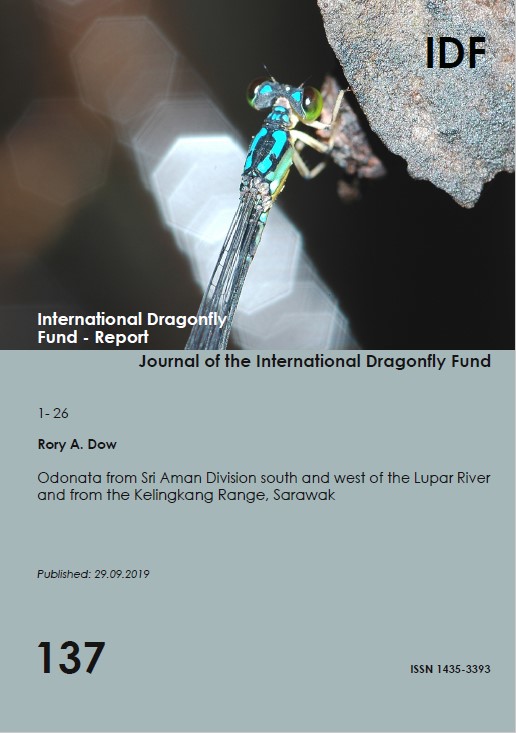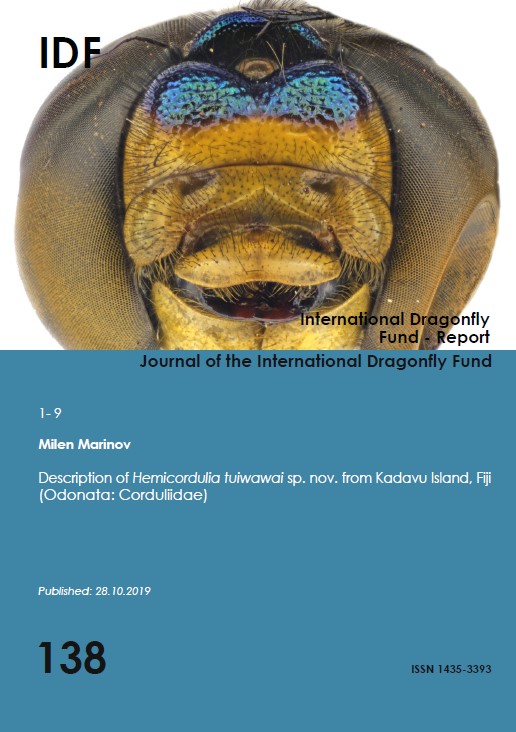International Dragonfly Fund – Report 135-141
Journal of the International Dragonfly Fund. Sammelband

Erscheinungsjahr: 2020
Seitenzahl: 198 (Zahlreiche Farbfotos, Karten, Tabellen und Diagramme)
Format: 21 x 15 cm (Paperback)
ISBN: 978-3-931921-28-6
Preis: 24,50 €
Dieser Sammelband enthält 7 Forschungsarbeiten mit insgesamt 198 Seiten sowie zahlreichen Farbfotos, Verbreitungskarten, Tabelle und Diagrammen:

IDF-Report 135: Eric Durand (2019) – Dragonfly species new or rare to the Odonata fauna of Georgia, Armenia and Azerbaijan. 23 Seiten
During four field trips in Georgia, Armenia and Azerbaijan from 2010 to 2018, the author collected data of a total of 55 species (see Tab. 2 in Appendix). This study provides first insights into new or rare species in this ecoregion. Ischnura fountaineae and Cordulia aenea were found for the first time in Armenia. We also highlight the rediscovery of some species that were mentioned in the older literature but had not been confirmed since. An autochthonous population of Lestes macrostigma was discovered in Azerbaijan sixteen years after the single previous record by Dumont (2004). Original information is provided on the distribution of some rare species encountered in these countries. Finally, the identification of a puzzling Cordulegaster sp. observed in south Armenia is discussed briefly.
Key words: Distribution, southern Caucasus ecoregion, Lestes macrostigma, Ischnura fountaineae, Cordulia aenea, Leucorrhinia pectoralis, Aeshna cyanea, Sympetrum danae, Selysiothemis nigra, Gomphus schneiderii, Onychogomphus assimilis, Cordulegaster insignis, Cordulegaster sp., new records

IDF-Report 136: Oleg E. Kosterin (2019) – Odonatological results of a trip across the southern Far East of Russia in the first half of July 2014. 65 Seiten
border of North Korea to Khabarovsk from July 1st to 16th, 2014, are presented. In total, 50 species were recorded, including those with limited presence in Russia, such as Paracercion calamorum, P. hieroglyphicum, P. plagiosum (for this species the 3rd Russian locality is reported), Pseudocopera tokyoensis, Stylurus annulatus (2nd Russian locality), Sinictinogomphus clavatus; Trigomphus citimus, Macromia daimoji (3rd Russian locality), M. manchurica, Deielia phaon, Lyriothemis pachygastra (2nd Russian locality). For S. annulatus, M. manchurica and D. phaon the northernmost known localities in the world are reported. D. phaon, earlier reported from one locality in Russia, have been found in five localities in Primorye and for the first time reported for Khabarovskiy Kray in general and Bol’shekhekhtsirskiy State Nature Reserve in particular. A trend of mutual exclusion of two abundant Shaogomphus postocularis epophthalmus and S. schmidti is supposed: the lowermost Ussuri River / Amur River, respectively. Variation in Paracercion spp. and Macromia amphigena fraenata is discussed.
Key words: Odonata, dragonflies, damselflies, Russia, Far East, Primorye, Primorskiy Kray, Khabarovskiy Kray, Khabarovsk, Bol’shekhekhtsirskiy State Nature Reserve, Lake Khanka, the Ussuri River, the Amir River, Macromia amphigena fraenata, Macromia daimoji, Paracercion vnigrum, Paracercion hieroglyphicum, Shaogomphus postocularis epophthalmus, Shaogomphus schmidti, world northernmost records

IDF-Report 137: Rory A. Dow (2019) – Odonata from Sri Aman Division south and west of the Lupar River and from the Kelingkang Range, Sarawak. 26 Seiten
Records of Odonata from the southwest of Sri Aman Division and the extreme east of Serian Division in Sarawak are presented. The sampled areas are interesting not only because they are poorly known for Odonata but also because many are just to the south and west of the Lupar Line which is a division between the ancient Sunda shelf and more recent geological formations. Differences between the odonate faunas on either side of the Lupar Line are discussed. Eightyfive species of Odonata were recorded during the surveys reported on. The single most notable record is that of Coeliccia southwelli Dow & Reels, 2011, which represents a considerable extension to the known range of this species. Other interesting records include Telosticta dupophila (Lieftinck, 1933), T. species cf longigaster Dow & Orr, 2012, Podolestes parvus Dow & Ngiam, 2019 and Heliogomphus species cf olivaceous Lieftinck, 1961. Variation in the markings of Stenagrion dubium (Laidlaw, 1912) across its range is discussed and a gene tree using the COI marker is presented to illustrate the high variability of this species in this marker. However the variability in COI does not appear to be correlated with other characters.
Key words: Lupar River, Lupar Line, Stenagrion dubium, DNA barcoding, Coeliccia southwelli

IDF-Report 138: Milen Marinov (2019) – Description of Hemicordulia tuiwawai sp. nov. from Kadavu Island, Fiji (Odonata: Corduliidae). 9 Seiten
Hemicordulia tuiwawai sp. nov. (Odonata: Corduliidae) is described and diagnosed based on material collected from Kadavu Island, Fiji; holotype: Wainitayuki River about 750 m above Baidamudamu village, 19.0916, 178.1038; 37 m a.s.l., 06 June 2016, M. Marinov leg. This species is distinguished from its congeners in the field by the contrasting colouration – dark green metallic body with bright yellow spots on the synthorax and base of the abdomen. This pattern is comparable to H. pacifica Selys, 1871. However, Hemicordulia tuiwawai sp. nov. can be recognised by the larger size and unique shape of the caudal appendages and genital hamule (in males) and vulvar scale (in females).
Key words: Odonata, Kadavu, Fiji, Hemicordulia, new species

IDF-Report 139: Ngo Quoc Phu, Phan Quoc Toan & Van Quang To (2019) – Description of the female of Davidius monastyrskii Do, 2005 from the Central Highlands of Vietnam (Odonata: Gomphidae). 6 Seiten
The first description of the female of Davidius monastyrskii Do, 2005 is made, based on a specimen from the Central Highlands of Vietnam (Mang Yang District, Gia Lai Province).
Key words: Odonata, Gomphidae, Davidius monastyrskii, female, Vietnam

IDF-Report 140: Anna Rychła (2019) – Besiedlung künstlicher Kleingewässer durch Großlibellen (Odonata: Anisoptera) – eine 4-jährige Studie aus der Niederschlesischen Heide (SW Polen). 19 Seiten
Neu angelegte Kleingewässer werden oft durch Libellen rasch als Lebensräume in Anspruch genommen. Allerdings ist über die dauerhafte Bildung von Populationen, vor allem durch seltene und gefährdete Arten, noch wenig bekannt. Ziel dieser Studie war die Untersuchung des Besiedlungsprozesses von künstlich angelegten Gewässern durch Libellen mit besonderem Fokus auf moortypische Arten. In den Jahren 2015–2018 wurden in der Niederschlesischen Heide an sechs solchen Gewässern, drei neuen und drei alten, Exuvien von Großlibellen (Anisoptera) quantitativ aufgesammelt. Die Erfassung des Besiedlungserfolges durch Kleinlibellen (Zygoptera) erfolgte qualitativ als Zusatzinformation zur Artenvielfalt der Gewässer. Insgesamt waren 26 Libellenarten – 9 Zygoptera und 17 Anisoptera – bodenständig. Allerdings variierte der Artenreichtum deutlich sowohl zwischen den Gewässern als auch den Untersuchungsjahren, so dass sich keine klar definierten Unterschiede in der Artenvielfalt zwischen den neuen und alten Gewässern erkennen ließen. Unter den bodenständigen Arten wurden vier moortypische Großlibellen (Aeshna juncea, Leucorrhinia dubia, L. albifrons, L. pectoralis) nachgewiesen. Ununterbrochene Entwicklung ließ sich nur für A. juncea und L. dubia in einzelnen Gewässern bestätigen. Leucorrhinia albifrons kam nur sporadisch vor und wurde im letzten Untersuchungsjahr (2018) nicht mehr gefunden. Dagegen vollendete L. pectoralis ihre Entwicklung erst in den Jahren 2017–2018. Generell bevorzugten diese Arten Gewässer, in denen die Vegetation mäßig bis gut entwickelt war. Die Ergebnisse bestätigen, dass künstliche Gewässer durch ein breites Spektrum von Arten erfolgreich besiedelt werden können. Allerdings ließ sich die dauerhafte Reproduktion in den jeweiligen Gewässern nur für wenige Großlibellen nachweisen. Deshalb sind die Gewässer in der Niederschlesischen Heide nicht als langfristige Ersatzbiotope, sondern vielmehr als temporäre Fortpflanzungsbiotope von Individuen der Nebenpopulationen zu sehen.

IDF-Report 141: Philip O.M. Steinhoff, Rambli Ahmad, Stephen G. Butler, Chee Yen Choong, Rory A. Dow & Graham T. Reels (2019) – Odonata of Gunong Mulu National Park in Sarawak, Malaysian Borneo. 50 Seiten
Records of Odonata collected in Gunong Mulu National Park in Sarawak are presented. Between 2005 and 2019, in 12 surveys that lasted between one week and five months, 163 species were collected. The collections from Gunong Mulu National Park are of importance for the taxonomic study of dragonflies and damselflies in Borneo; several species have been described based on material collected in the Park.